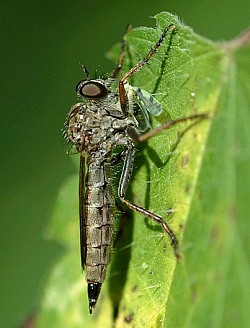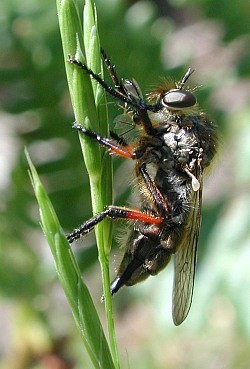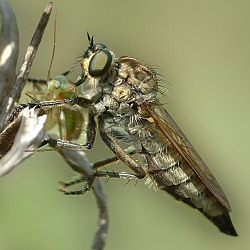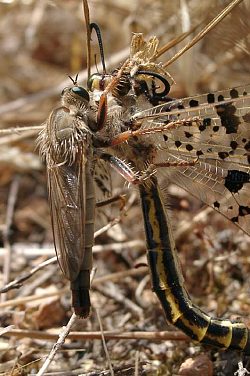|
 LAVIGNE & HOLLAND (1969): "Although early observers (Duncan, 1882) accepted the belief that asilids feed on cattle and other large mammals, it is now known that arthropods compose the complete diet of adult robber flies. The great majority of prey are insects, but some asilids have been reproted to prey on Arachnidae. Bristowe (1924) reported two instances of Plesiomma fuliginosum (Weid.) feeding on the spider, Epeira grayi Bl., in the centers of the spider's web. Efferia barbata (F.) took the jumping spider, Pellenes agilis Bks., as prey (Painter, 1926). Stichopogon trifasciatus occasionally utilizes spieders for food (Fattig, 1945; Bromley 1931, 1934, 1946, 1950) as does H. wilcoxi, as noted in this paper. Spiders were among the prey of Psilocurus nudiusculus Loew and Diogmites symmachus Loew (Bromley, 1934) and Deromyia umbrina Loew [= Diogmites basalis) (Walker)] (McAtee and Banks, 1920). Three families of spiders, Salticidae, Clubionidae and Agriopidae, were recorded as prey of Neoitamus angusticornis Loew in Japan by Iwata and Nagatomi (1962). Longstaff (1910) recorded Asilus crabroniformis L. with a large Daddy-long-legs as prey in England."
LAVIGNE & HOLLAND (1969): "Although early observers (Duncan, 1882) accepted the belief that asilids feed on cattle and other large mammals, it is now known that arthropods compose the complete diet of adult robber flies. The great majority of prey are insects, but some asilids have been reproted to prey on Arachnidae. Bristowe (1924) reported two instances of Plesiomma fuliginosum (Weid.) feeding on the spider, Epeira grayi Bl., in the centers of the spider's web. Efferia barbata (F.) took the jumping spider, Pellenes agilis Bks., as prey (Painter, 1926). Stichopogon trifasciatus occasionally utilizes spieders for food (Fattig, 1945; Bromley 1931, 1934, 1946, 1950) as does H. wilcoxi, as noted in this paper. Spiders were among the prey of Psilocurus nudiusculus Loew and Diogmites symmachus Loew (Bromley, 1934) and Deromyia umbrina Loew [= Diogmites basalis) (Walker)] (McAtee and Banks, 1920). Three families of spiders, Salticidae, Clubionidae and Agriopidae, were recorded as prey of Neoitamus angusticornis Loew in Japan by Iwata and Nagatomi (1962). Longstaff (1910) recorded Asilus crabroniformis L. with a large Daddy-long-legs as prey in England."
Dr. R. Lavigne offers up a revised predator-prey database which now contains 13,445 records (Projects by R. Lavigne).
 WOOD (1981): "Species of some genera show a preference for one type of prey; for example species of Mallophorina attack Hymenoptera almost exclusively (Linsley 1960). Others, however, are more opportunistic, capturing whatever insects are available. In an extensive study of the ethology of 10 species of asilids, Dennis & Lavigne (1975) found that five were stenophagic, exhibiting a strong preference for prey of one or two orders, and five were euryphagic, taking prey from a broader range of orders. However, even some stenophagic species were observed to be opportunistic, switching their prey to another order when some particular insect was especially abundant. Scarbrough (1978) found that although 67% of all prey of the stenophagic Cerotainia albipilosa Curran belonged to Diptera and Hemiptera-Homoptera, these orders were also the most abundant at the study site."
WOOD (1981): "Species of some genera show a preference for one type of prey; for example species of Mallophorina attack Hymenoptera almost exclusively (Linsley 1960). Others, however, are more opportunistic, capturing whatever insects are available. In an extensive study of the ethology of 10 species of asilids, Dennis & Lavigne (1975) found that five were stenophagic, exhibiting a strong preference for prey of one or two orders, and five were euryphagic, taking prey from a broader range of orders. However, even some stenophagic species were observed to be opportunistic, switching their prey to another order when some particular insect was especially abundant. Scarbrough (1978) found that although 67% of all prey of the stenophagic Cerotainia albipilosa Curran belonged to Diptera and Hemiptera-Homoptera, these orders were also the most abundant at the study site."
 The size of prey taken varies widely with each species of predator. Dennis & Lavigne (1975) found that the mean size ratio of predator to prey was 2.6:1, varying between 1.8:1 for larger predators and 3.7:1 for smaller predators. The smaller asilid species had larger predator to prey ratios, presumably because they were weaker and would not be able to subdue larger prey. An asilid may fly out after a prey that is much too large but he avoids it just before capture, or grasps it for a few seconds then releases it again (Scarbrough 1978). Females of some species take larger prey than do males of the same species, but no sex differences have been noted for other species. Females also spend more time seeking prey than do males, possibly because of their reproductive requirements."
The size of prey taken varies widely with each species of predator. Dennis & Lavigne (1975) found that the mean size ratio of predator to prey was 2.6:1, varying between 1.8:1 for larger predators and 3.7:1 for smaller predators. The smaller asilid species had larger predator to prey ratios, presumably because they were weaker and would not be able to subdue larger prey. An asilid may fly out after a prey that is much too large but he avoids it just before capture, or grasps it for a few seconds then releases it again (Scarbrough 1978). Females of some species take larger prey than do males of the same species, but no sex differences have been noted for other species. Females also spend more time seeking prey than do males, possibly because of their reproductive requirements."
 Stenopogon spec. with Palpares libelluloides as prey (which has body length of 60 mm)
Stenopogon spec. with Palpares libelluloides as prey (which has body length of 60 mm)
Photography: © Mike Taylor
| |